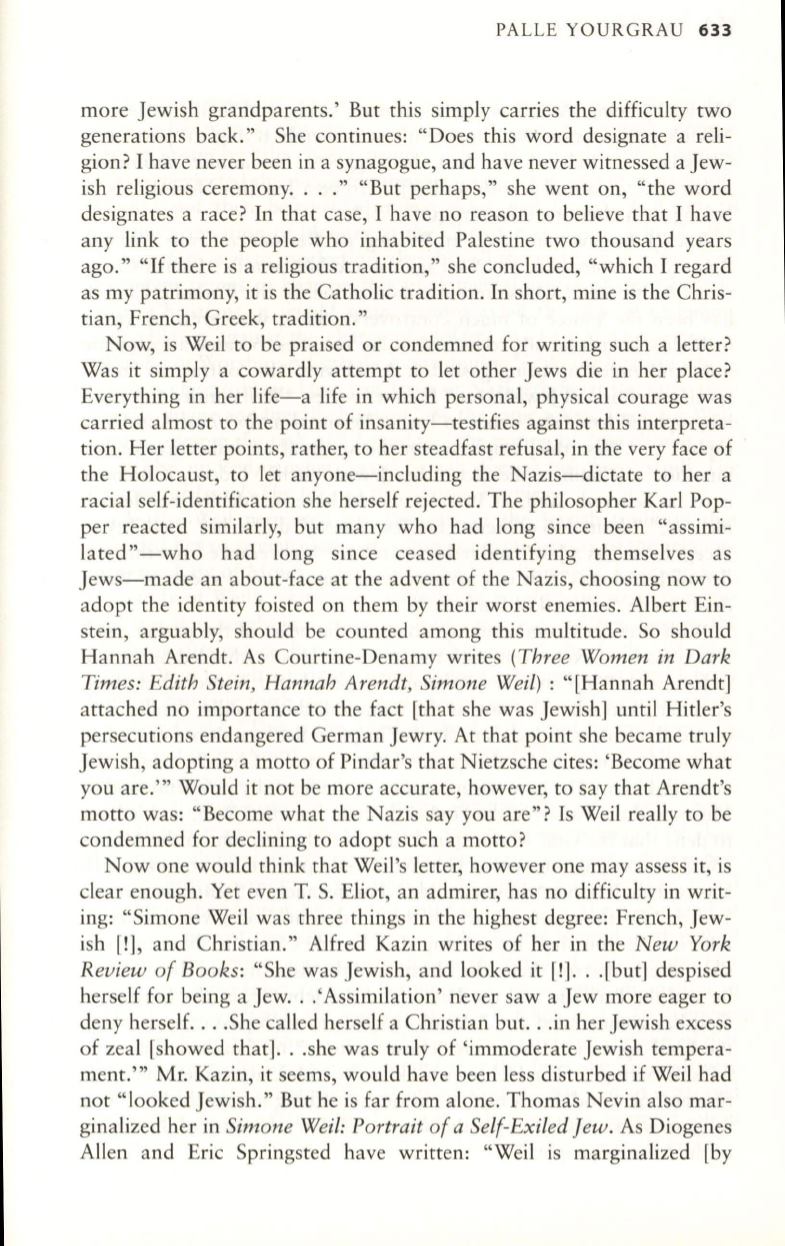
PALLE YOURGRAU
633
more Jewish grandparents.' But this simply carries the difficulty two
generations back." She continues: "Does this word designate a reli–
gion? I have never been in a synagogue, and have never witnessed a Jew–
ish religious ceremony...." "But perhaps," she went on, "the word
designates a race? In that case, I have no reason to believe that I have
any link to the people who inhabited Palestine two thousand years
ago."
"If
there is a religious tradition," she concluded, "which I regard
as my patrimony, it is the Catholic tradition. In short, mine is the Chris–
tian, French, Greek, tradition."
Now, is Weil to be praised or condemned for writing such a letter?
Was it simply a cowardly attempt to let other Jews die in her place?
Everything in her life-a life in which personal, physical courage was
carried almost to the point of insanity-testifies against this interpreta–
tion. Her letter points, rather, to her steadfast refusal, in the very face of
the Holocaust, to let anyone-including the Nazis-dictate to her a
racial self-identification she herself rejected. The philosopher Karl Pop–
per reacted similarly, but many who had long since been "assimi–
lated"-who had long since ceased identifying themselves as
Jews-made an about-face at the advent of the Nazis, choosing now to
adopt the identity foisted on them by their worst enemies. Albert Ein–
stein, arguably, should be counted among this multitude. So should
Hannah Arendt. As Courtine-Denamy writes
(Three Women in Dark
Times: Edith Stein, Hannah Arendt, Simone Weill
:
"[Hannah Arendt]
attached no importance to the fact [that she was Jewish] until Hitler's
persecutions endangered German Jewry. At that point she became truly
Jewish, adopting a motto of Pindar's that Nietzsche cites: 'Become what
you are.'" Would it not be more accurate, however, to say that Arendt's
motto was: "Become what the Nazis say you are"? Is Weil really to be
condemned for declining to adopt such a motto?
Now one would think that Weil's letter, however one may assess it, is
clear enough. Yet even
T.
S. Eliot, an admirer, has no difficulty in writ–
ing: "Simone Weil was three things in the highest degree: French, Jew–
ish
[!],
and Christian." Alfred Kazin writes of her in the
New York
Review of Books:
"She was Jewish, and looked it
[!] ...
[but] despised
herself for being a Jew.. .'Assimilation' never saw a Jew more eager to
deny herself....She called herself a Christian but.. .in her Jewish excess
of zeal [showed that] ...she was truly of 'immoderate Jewish tempera–
ment.''' Mr. Kazin, it seems, would have been less disturbed if Wei! had
not "looked Jewish." But he is far from alone. Thomas Nevin also mar–
ginalized her in
Simone Wei!: Portrait of a Self-Exiled Jew.
As Diogenes
Allen and Eric Springsted have written: "Weil is marginalized [by


